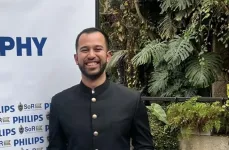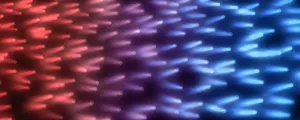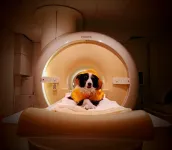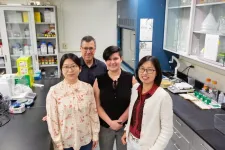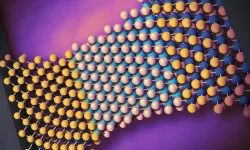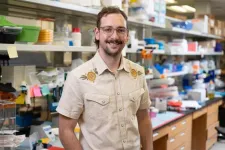(Press-News.org) ITHACA, N.Y. -- In sea fireflies’ underwater ballet, the males sway together in perfect, illuminated synchronization, basking in the glow of their secreted iridescent mucus.
“It’s extreme,” said Nicholai M. Hensley, a postdoctoral fellow in the Department of Neurobiology and Behavior in the College of Arts and Sciences. “It’s an illustration of convergent evolution and a striking example of synchronized bioluminescent mating displays. The males are putting it all out on the dance floor. It’s a big bright display.”
Hensley is the lead author of new research unwrapping the vivid mating ritual of minute crustaceans called ostracods, which was published Nov. 29 in the Proceedings of the Royal Society B.
Ostracods are tiny crustaceans – the size of sesame seeds – found just offshore in the sandy seagrass and reef areas of marine waters. Males of the shrimplike species, called “entraining grassbed downer” or EGD for short, create distinct patterns of bioluminescence to attract females by secreting packets of protein from a specialized gland. In response, the females angle themselves to the bright blue luminous displays and swim toward the males.
“It starts with one male secreting a little ball of glowing mucus,” Hensley said. “Then repeats this several times while swimming and it creates a kind of Morse code pattern of light in the water. Then other males start their synchronous luminous displays and soon underwater – when it is dark – it looks like stars blinking with tiny trails of light.”
The synchronized swim doesn’t happen randomly, the scientists noticed. In fact, the mating dance sequence only happens after sunset at nautical twilight when the moon isn’t bright in the night sky.
The ostracod species EGD was first discovered in 2017 by James Morin, professor emeritus of ecology and evolutionary biology (A&S) and Todd Oakley, professor at the University of California, Santa Barbara, while they explored near the Smithsonian Tropical Research Institute’s Bocas del Toro island research station in Panama.
Morin, who has studied the mechanisms of bioluminescence in marine organisms since 1980, said there are more than 100 species of signaling ostracods in the Caribbean.
“What’s really remarkable about EGD is the duration, the brightness and the density,” Morin said. He recounted while diving at night how a cloudy wave of glowing ostracods moved past him. “It was a remarkable experience. They really jump out at you. I’ve worked with ostracods for years and this species is spectacular.”
Ostracod shared a common ancestor with fireflies about 500 million years ago during the Cambrian era, Hensley said, but courtship using the light likely evolved about 20 million years ago.
But why should sea firefly males go through these gyrations? Other scientific evidence shows that synchronous male behavior entices groups of females, Hensley said. “We’re not sure about the function of synchrony itself,” he said. “All we know now is that these displays are used to attract mates.”
Hensley conducted this research as a doctoral student at the University of California, Santa Barbara. In addition to authors Hensley and Oakley, the co-authors on this paper, “Collective Synchrony of Mating Signals Modulated by Ecological Cues and Social Signals in Bioluminescent Sea Fireflies,” were Trevor J. Rivers, Ph.D. ’07, assistant teaching professor at the University of Kansas; Gretchen A. Gerrish, Ph.D. ‘07, director, Center for Limnology, University of Wisconsin, Madison; and Raj Saha, Roux Institute, Northeastern University, Portland, Maine.
The National Science Foundation funded this research.
-30-
END
Sea fireflies synchronize their sparkle to seek soulmates
2023-11-30
ELSE PRESS RELEASES FROM THIS DATE:
Structural racism persists in radiotherapy
2023-11-30
Philadelphia, November 30, 2023 – Everyone should get quality care, no matter the color of their skin. However, implicit bias, micro-aggressions, and a lack of cultural understanding persist, leading to oppression and unequal treatment in healthcare. An insightful article in the new themed issue of the Journal of Medical Imaging and Radiation Sciences on specialized populations, published by Elsevier, highlights this serious problem, specifically addressing the assessment and treatment of radiation-induced skin reactions (RISR) in patients across the world undergoing external beam radiotherapy.
The article provides a stark example ...
BU researcher receives K01 grant to study how nutrition impacts TB incidence, mortality
2023-11-30
(Boston)—Pranay Sinha, MD, assistant professor of medicine at Boston University Chobanian & Avedisian School of Medicine, has received a National Institutes of Health Mentored Research Scientist Development Award (K01). These awards provide support and protected time (three to five years) for an intensive, supervised, career development experience in the biomedical, behavioral or clinical sciences, leading to research independence.
As part of this honor, Sinha has received a five-year, $640,508 National Institute of Allergy and Infectious Diseases grant for his project, “Nutritional Interventions to End Tuberculosis ...
Researchers show an old law still holds for quirky quantum materials
2023-11-30
Long before researchers discovered the electron and its role in generating electrical current, they knew about electricity and were exploring its potential. One thing they learned early on was that metals were great conductors of both electricity and heat.
And in 1853, two scientists showed that those two admirable properties of metals were somehow related: At any given temperature, the ratio of electronic conductivity to thermal conductivity was roughly the same in any metal they tested. This so-called Wiedemann-Franz law has held ever since – except in quantum materials, where electrons stop behaving as individual particles and glom together into a sort of electron soup. ...
Pickier dogs have pickier brains
2023-11-30
Dogs’ food preferences are mirrored in their brain activity, particularly within their caudate nuclei -a brain region associated with reward processing, a new study combining behavioural and neuroimaging data by researchers from the Department of Ethology, Eötvös Loránd University (Hungary) and Symrise Pet Food (France) finds. The study, which seamlessly blends behavioral observations with advanced neuroimaging techniques, offers novel insights into the influence of food quality on dogs' motivation. This work has been published in Scientific Reports.
Similar to people, ...
Despite pressures facing young families, parents take precious moments to play with their babies
2023-11-30
Four in five primary caregivers of nine-month-old babies reported cuddling, talking and playing with their little one several times a day, in England's first national long-term study of babies in over two decades, led by UCL (University College London).
More than half engaged in physical or turn-taking play, singing, pretend games and noisy play with their babies several times a day – activities which were linked to improved early language development. Around three quarters showed their babies picture ...
Combined use of alcohol and THC can affect rat brains, study finds
2023-11-30
The increased legalization of cannabis over the past several years can potentially increase its co-use with alcohol. Concerningly, very few studies have looked at the effects of these two drugs when used in combination. In a series of new studies, researchers at the University of Illinois Urbana-Champaign used rats to understand how brain structure and behavior can change when cannabis and alcohol are taken together.
Most researchers have studied the effects of either alcohol or THC (delta-9-tetrahydrocannabinol), the primary psychoactive drug in cannabis, alone. However, when people, especially adolescents, use these drugs, ...
Tis the season to recognize chocolate: researchers highlight high quality cacao in Colombia
2023-11-30
Scientists are working to protect the unique qualities of cacao beans grown in the Buenaventura region on the Pacific coast of Colombia.
In a study published in the Journal of the Science of Food and Agriculture, researchers from the Colombian Corporation for Agricultural Research (AGROSAVIA) have examined a wealth of metrics to uncover the complex interactions between environmental factors and cacao quality.
In a pioneering move, they have proposed that Buenaventura should be designated as a new Denomination of Origin (DO) for cacao trees. This is a legal recognition given to products that originate ...
Straining memory leads to new computing possibilities
2023-11-30
By strategically straining materials that are as thin as a single layer of atoms, University of Rochester scientists have developed a new form of computing memory that is at once fast, dense, and low-power. The researchers outline their new hybrid resistive switches in a study published in Nature Electronics.
Developed in the lab of Stephen M. Wu, an assistant professor of electrical and computer engineering and of physics, the approach marries the best qualities of two existing forms of resistive switches used for memory: memristors and phase-change materials. Both forms have been explored for their advantages over ...
Antarctica's ancient ice sheets foreshadow dynamic changes in Earth’s future
2023-11-30
MADISON – Nineteen million years ago, during a time known as the early Miocene, massive ice sheets in Antarctica rapidly and repeatedly grew and receded. The Miocene is widely considered a potential analog for Earth's climate in the coming century, should humanity remain on its current carbon emissions trajectory.
Identifying how and why Antarctica's major ice sheets behaved the way they did in the early Miocene could help inform understanding of the sheets' behavior under a warming climate. Together, the ice sheets lock a volume of water equivalent to more than 50 meters of sea level rise and influence ocean currents that affect marine food webs and regional climates. ...
Modular chimeric cytokine receptors improve CAR T–cell therapy for solid tumors
2023-11-30
(MEMPHIS, Tenn. – November 30, 2023) Immunotherapy using modified chimeric antigen receptor (CAR) T cells has greatly improved survival rates for pediatric patients with relapsed and recurrent leukemia. However, these therapies are not as effective in treating solid tumors and can have significant toxicity. Findings from St. Jude Children’s Research Hospital showed that adding a modular chimeric cytokine receptor to CAR T cells increased their efficacy in multiple solid tumor models. The study was published today in Nature Biomedical Engineering.
“We designed modular chimeric cytokine receptors and showed that ...
